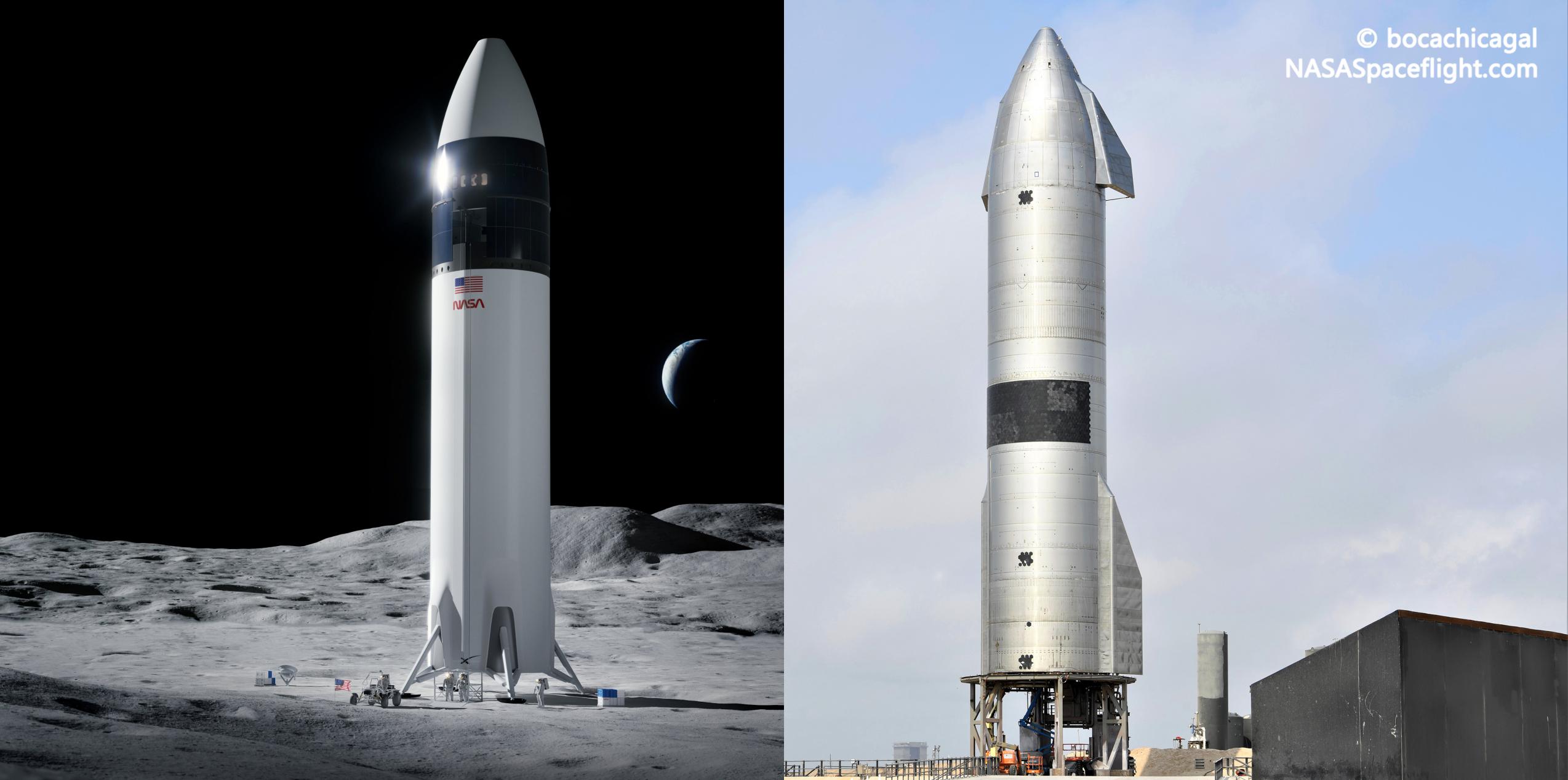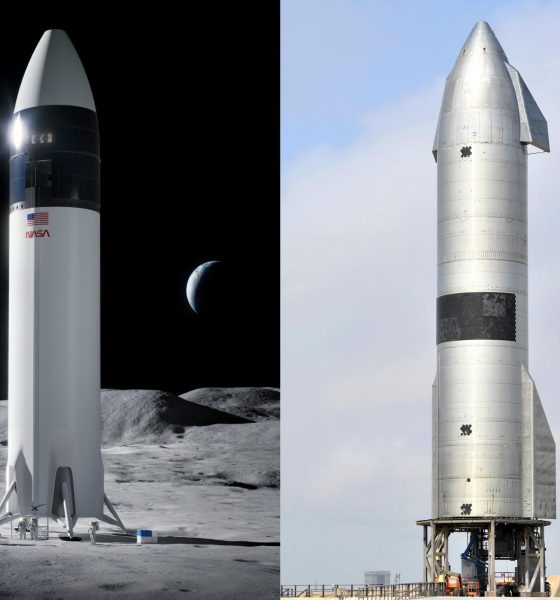

News
SpaceX’s NASA Starship contract safe for now as Blue Origin looks to Congress
Fresh off of a major contract loss during a competition to build NASA’s next crewed Moon lander, Blue Origin has begun aggressively lobbying Congress for the contract NASA didn’t give it.
Thankfully, albeit not at first, a modification has been made to an amendment first proposed by a Senator that has long pursued favorable treatment of Blue Origin that will prevent that legislation – if it passes – from unfairly interrupting the $2.9 billion contract NASA already awarded SpaceX. Announced on April 16th, that award came as a shock, effectively cementing SpaceX’s lunar Starship as both the cheapest and most technically sound proposal to return humanity to the Moon.
As such, although NASA made it clear that it would have selected two of the three competing proposals in a perfect scenario, Congress allocated just a quarter of the Human Landing System (HLS) funding NASA requested, forcing the agency between a rock and a hard place.
NASA repeatedly stated as much both before and after the decision was announced, effectively implying that the agency had learned its lesson with the Commercial Crew Program, in which it had selected two redundant providers – Boeing and SpaceX – only for Congress to systematically underfund the program for years. As a direct result of years of underfunding during an early and formative period, both providers suffered at least 2-3 years of delays, followed by another few years of more organic delays as development matured and new challenges were unsurprisingly uncovered.
Politically, NASA could never say that – effectively biting the hand that (under)feeds – out loud, but it was strongly implied in an official HLS source selection statement released to partially explain why it had chosen SpaceX and SpaceX alone. Almost instantly, both losing competitors – Blue Origin and Dynetics – filed protests with the US Government Accountability Office (GAO) filled with far more bizarre, rambling tangents than coherent legal arguments.
Unless GAO operates on a different standard than the court of law or uncovers something nefarious behind closed doors, a close reading of both partially redacted protests does not bode well for either document’s ability to sway the office’s opinion. Almost as if Blue Origin itself is aware of just how frivolous its protest really is, the company – seemingly backed by partners Northrop Grumman, Lockheed Martin, and Leidos – wasted no time lobbying Senator Maria Cantwell for an alternate avenue to get what it wants and the government money founder Jeff Bezos feels entitled to.
Cantwell represents Washington State, where both Amazon and Blue Origin are headquartered, and has frequently spoken out in support of – or personally introduced – legislation that would specifically favor Bezos’ space company. On May 12th, Cantwell introduced an amendment that would purportedly “maintain competitiveness” by forcing NASA to select a second HLS winner in addition to SpaceX. Without irony, the authorization bill also demanded that NASA make that decision within a mere 30 days.
Under those conditions, Congress would authorize $10 billion for NASA to develop and demonstrate two landers with an uncrewed and crewed Moon landing each – the original plan. Insultingly, Cantwell tacked that amendment onto an authorization bill, meaning that even if Congress were to pass the bill and the President were to sign it into law, Congress would still have to actually allocate that $10 billion in the form of a more than 10% boost to NASA’s annual budget. Historically, even if Congress were to defy all recent precedent and significantly boost NASA’s 2022 budget, there is no guarantee that that raise would be upheld for four or more years, which it would need to be for the authorization bill to be anything more than a hollow promise.
More recently, a clause was thankfully added clarifying that NASA is not allowed to “modify, terminate, or rescind” SpaceX’s HLS contract to comply with the amendment. Additionally, while still amounting to a legal gun to NASA’s head to force it to into a contract it knows it cant afford, the modification gives NASA 60 days to award a second lander contract. Based on the agency’s own selection statement, Blue Origin’s National Team would almost certainly be the recipient in the event that the bill becomes law, forcing NASA to commit more than $9 billion – instead of $2.9 billion – to the next stage of HLS development with no guarantee that its budget will be raised accordingly.
In the meantime, GAO still has to complete its reviews of Blue Origin and Dynetic’s protests and the White House has to submit its FY2022 budget request and consider adding NASA funding to its proposed jobs and infrastructure package.

News
Tesla starts showing how FSD will change lives in Europe
Local officials tested the system on narrow country roads and were impressed by FSD’s smooth, human-like driving, with some calling the service a game-changer for everyday life in areas that are far from urban centers.

Tesla has launched Europe’s first public shuttle service using Full Self-Driving (Supervised) in the rural Eifelkreis Bitburg-Prüm region of Germany, demonstrating how the technology can restore independence and mobility for people who struggle with limited transport options.
Local officials tested the system on narrow country roads and were impressed by FSD’s smooth, human-like driving, with some calling the service a game-changer for everyday life in areas that are far from urban centers.
Officials see real impact on rural residents
Arzfeld Mayor Johannes Kuhl and District Administrator Andreas Kruppert personally tested the Tesla shuttle service. This allowed them to see just how well FSD navigated winding lanes and rural roads confidently. Kruppert said, “Autonomous driving sounds like science fiction to many, but we simply see here that it works totally well in rural regions too.” Kuhl, for his part, also noted that FSD “feels like a very experienced driver.”
The pilot complements the area’s “Citizen Bus” program, which provides on-demand rides for elderly residents who can no longer drive themselves. Tesla Europe shared a video of a demonstration of the service, highlighting how FSD gives people their freedom back, even in places where public transport is not as prevalent.
What the Ministry for Economic Affairs and Transport says
Rhineland-Palatinate’s Minister Daniela Schmitt supported the project, praising the collaboration that made this “first of its kind in Europe” possible. As per the ministry, the rural rollout for the service shows FSD’s potential beyond major cities, and it delivers tangible benefits like grocery runs, doctor visits, and social connections for isolated residents.
“Reliable and flexible mobility is especially vital in rural areas. With the launch of a shuttle service using self-driving vehicles (FSD supervised) by Tesla in the Eifelkreis Bitburg-Prüm, an innovative pilot project is now getting underway that complements local community bus services. It is the first project of its kind in Europe.
“The result is a real gain for rural mobility: greater accessibility, more flexibility and tangible benefits for everyday life. A strong signal for innovation, cooperation and future-oriented mobility beyond urban centers,” the ministry wrote in a LinkedIn post.
News
Tesla China quietly posts Robotaxi-related job listing
Tesla China is currently seeking a Low Voltage Electrical Engineer to work on circuit board design for the company’s autonomous vehicles.

Tesla has posted a new job listing in Shanghai explicitly tied to its Robotaxi program, fueling speculation that the company is preparing to launch its dedicated autonomous ride-hailing service in China.
As noted in the listing, Tesla China is currently seeking a Low Voltage Electrical Engineer to work on circuit board design for the company’s autonomous vehicles.
Robotaxi-specific role
The listing, which was shared on social media platform X by industry watcher @tslaming, suggested that Tesla China is looking to fill the role urgently. The job listing itself specifically mentions that the person hired for the role will be working on the Low Voltage Hardware team, which would design the circuit boards that would serve as the nervous system of the Robotaxi.
Key tasks for the role, as indicated in the job listing, include collaboration with PCB layout, firmware, mechanical, program management, and validation teams, among other responsibilities. The role is based in Shanghai.
China Robotaxi launch
China represents a massive potential market for robotaxis, with its dense urban centers and supportive policies in select cities. Tesla has limited permission to roll out FSD in the country, though despite this, its vehicles have been hailed as among the best in the market when it comes to autonomous features. So far, at least, it appears that China supports Tesla’s FSD and Robotaxi rollout.
This was hinted at in November, when Tesla brought the Cybercab to the 8th China International Import Expo (CIIE) in Shanghai, marking the first time that the autonomous two-seater was brought to the Asia-Pacific region. The vehicle, despite not having a release date in China, received a significant amount of interest among the event’s attendees.
Elon Musk
Elon Musk and Tesla AI Director share insights after empty driver seat Robotaxi rides
The executives’ unoccupied tests hint at the rapid progress of Tesla’s unsupervised Robotaxi efforts.

Tesla CEO Elon Musk and AI Director Ashok Elluswamy celebrated Christmas Eve by sharing personal experiences with Robotaxi vehicles that had no safety monitor or occupant in the driver’s seat. Musk described the system’s “perfect driving” around Austin, while Elluswamy posted video from the back seat, calling it “an amazing experience.”
The executives’ unoccupied tests hint at the rapid progress of Tesla’s unsupervised Robotaxi efforts.
Elon and Ashok’s firsthand Robotaxi insights
Prior to Musk and the Tesla AI Director’s posts, sightings of unmanned Teslas navigating public roads were widely shared on social media. One such vehicle was spotted in Austin, Texas, which Elon Musk acknowleged by stating that “Testing is underway with no occupants in the car.”
Based on his Christmas Eve post, Musk seemed to have tested an unmanned Tesla himself. “A Tesla with no safety monitor in the car and me sitting in the passenger seat took me all around Austin on Sunday with perfect driving,” Musk wrote in his post.
Elluswamy responded with a 2-minute video showing himself in the rear of an unmanned Tesla. The video featured the vehicle’s empty front seats, as well as its smooth handling through real-world traffic. He captioned his video with the words, “It’s an amazing experience!”
Towards Unsupervised operations
During an xAI Hackathon earlier this month, Elon Musk mentioned that Tesla owed be removing Safety Monitors from its Robotaxis in Austin in just three weeks. “Unsupervised is pretty much solved at this point. So there will be Tesla Robotaxis operating in Austin with no one in them. Not even anyone in the passenger seat in about three weeks,” he said. Musk echoed similar estimates at the 2025 Annual Shareholder Meeting and the Q3 2025 earnings call.
Considering the insights that were posted Musk and Elluswamy, it does appear that Tesla is working hard towards operating its Robotaxis with no safety monitors. This is quite impressive considering that the service was launched just earlier this year.








